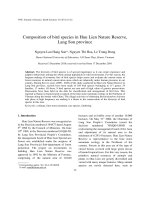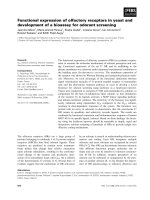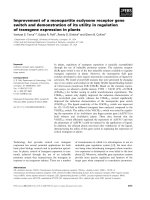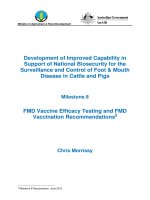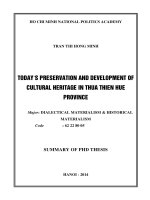Conservation and development of medicinal plants in pu hu nature reserve thanh hoa province
Bạn đang xem bản rút gọn của tài liệu. Xem và tải ngay bản đầy đủ của tài liệu tại đây (1.52 MB, 79 trang )
MINISTRY OF AGRICULTURE AND RURAL DEVELOPMENT
VIETNAM NATIONAL UNIVERSITY OF FORESTRY
STUDENT THESIS
CONSERVATION AND DEVELOPMENT OF MEDICINAL PLANTS
IN PU HU NATURE RESERVE, THANH HOA PROVINCE.
Major: Natural Resources Management
Code: D850101
Faculty: Forest Resource and Environmental Management
Student: Nguyen Thi Thuy Duong
Student ID: 1453091257
Class: K59A - Natural Resources Management
Course: 2014 – 2018
Advance Education Program
Developed in collaboration with Colorado State University, USA
Supervisor: Professor Dr. Hoang Van Sam
Hanoi, 2018
ACKNOWLEDGEMENT
To complete this research, apart from my own efforts, I have received a lot of enhance
and help from my teachers, organizations and individuals.
First and foremost, I would like to thank my research supervisors, Dr. Hoang Van Sam
with his support and understanding. Without his assistance and dedicated involvement in
every step throughout the process, this research would have never been accomplished.
I sincerely thank to Vietnam National University of Forestry has given me an
opportunity to apply the knowledge I learned from the school. I have got new and useful
experience that is helpful for my future work.
I would like to extend my thanks to the Board of Pu Hu Management especially Mr.
Le Duy Cuong - the vice director of Pu Hu Nature Reserve, Quan Hoa district, Thanh Hoa
Province for his useful, providing helpful data and constructive recommendations on this
research. I am also grateful to the stuffs of Pu Hu Reserve Manager: Le Phong, Hoang Van
Phu for taking good care of mine and supporting me with the enthusiastic guidance to
collected data when I stayed in the ranger station.
Last but not least, I would like to thank my family for supporting me spiritually
throughout my life.
i
ABSTRACT
Over three-quarters of the world population relies mainly on plants and plant extracts
for health care. More than 30% of the entire plant species, at one time or others were used for
medicinal purposes. Population rise, inadequate supply of drugs, prohibitive cost of
treatments, side effects of several allopathic drugs and development of resistance to currently
used drugs for infectious diseases have led to increased emphasis on the use of plant materials
as a source of medicines for a wide variety of human ailments.
Vietnam is a country with 75% mountainous area where ethic groups distributed. This
areas have many difficult conditions to develop the community also economic of community
especially transportation. The goods from urban areas are transported by a difficult way
including clothes, medicine…ect. Therefore, they have to have their own traditional culture
and experiences in the makeup and use medical plants. It led to the illegal harvesting
medicinal plants in the nature forest and effect to the growth and regeneration of medicinal
plants in nature forest.
This study aims at conservation and development of medicinal plants in Pu Hu Nature
Reserve. Collecting existed data, survey questionnaires were the methods used in data
collection. The study showed the current status of medicinal plants in Pu Hu Nature Reserve
includes: ingredient, habit, part-using, therapeutic, degree of threaten and status of harvesting
and planting. The study also provided information of ecological and distribution of Morinda
officinalis How as well as the factors impact on this species and made a documentation of
local people knowledge and development of medicinal plants in Pu Hu Nature Reserve. Last,
it gave solution for conservation and development of medicinal plants in Pu Hu Nature
Reserve.
ii
TABLE OF CONTENT
ACKNOWLEDGEMENT ........................................................................................................... i
ABSTRACT ............................................................................................................................... ii
TABLE OF CONTENT ............................................................................................................ iii
LIST OF ABBREVIATIONS .................................................................................................... v
LIST OF TABLE ....................................................................................................................... vi
LIST OF FIGURE .................................................................................................................... vii
I. INTRODUCTION................................................................................................................... 1
II. GOAL, SPECIFIC OBJECTIVES AND METHODOLOGY ............................................... 2
2.1 Goal .................................................................................................................................... 2
2.2 Objectives ............................................................................................................................. 2
2.3 Methods ................................................................................................................................ 2
2.3.1 Secondary data collection .................................................................................................. 2
2.3.2 Collect primary data .......................................................................................................... 2
2.3.3 Data analysis ...................................................................................................................... 5
2.3.4. Assess the level of threat .................................................................................................. 5
III. STUDY SITE CHARACTERISTICS .................................................................................. 6
3.1 Natural conditions. ............................................................................................................... 6
3.2. Social and economic conditions. ......................................................................................... 7
3.3. Basic characteristics of forest resources. ............................................................................. 7
3.3.1 Current status of land types, forest types of Pu Hu NR ..................................................... 7
3.3.2 Typical types of forest vegetation. .................................................................................... 8
IV. RESULTS AND DISCUSSION ........................................................................................ 10
4.1 Current status of medicinal plants in Pu Hu Nature Reserve ............................................. 10
4.1.1 Diversity of Taxon ........................................................................................................... 10
4.1.2 Usage of plant parts for medicine .................................................................................... 10
4.1.3 Habits of medicinal plants ............................................................................................... 11
4.1.4 Disease treated with medicinal plants ............................................................................. 11
4.1.5 Decree of threaten of medicinal plants in Pu Hu NR ...................................................... 12
4.1.6 Status of havesting, planting............................................................................................ 14
4.2 Status of Morinda officinalis How in Pu Hu NR ............................................................... 15
4.2.1 Distribution of Morinda officinalis How in Pu Hu NR ................................................... 15
4.2.2 Distribution characteristics of Morinda officinalis How in Pu Hu NR ........................... 16
4.2.3 Growth situation of Morinda officinalis How in Pu Hu NR ........................................... 18
iii
4.2.4 Factors impact on the growth of Morinda officinalis How in Pu Hu NR ....................... 19
4.2.5 Trading situation of Morinda officinalis How in Pu Hu NR ........................................... 19
4.3 Local people’s knowledge and development of medicinal plants in Pu Hu NR ................ 20
4.4 Solution proposals for conservation and development of medicinal plants in Pu Hu NR. 21
V. CONCLUSION ................................................................................................................... 22
REFERENCES
APPENDIX
iv
LIST OF ABBREVIATIONS
NR
Nature Reserve
IUCN
International Union for Conservation of Nature
VU
Vulnerable
LR
Lower risk
LC
Least concern
EN
Endangered
DD
Data deficient
NTFPs
Non-timber forest products
v
LIST OF TABLE
Table 2.1
Coordinate of start, end point of each trasect line
Table 3.1
Classification of vegetation
Table 4.1
Medicinal plants found in Pu Hu Nature Reserve
Table 4.2
Group of diseases treated with medicinal plants by local people
Table 4.3
Endangered species of medicinal plant found in Pu Hu NR
Table 4.4
Forest status where Morinda officinalis How grow
Table 4.5
Stand information in each plot
Table 4.6
Factors impact on the growth of Morinda officinalis How in each plot
vi
LIST OF FIGURE
Figure 2.1 Distribution map of transect line investigation in Pu Hu NR
Figure 2.2 Distribution map of transect line and plot investigation in Pu Hu NR
Figure 3.1 Map of Pu Hu NR
Figure 4.1 Usage of plant parts for medicine in Pu Hu NR
Figure 4.2 Habit of medicinal plants in Pu Hu NR
Figure 4.3 Harvesting’s frequency of local people
Figure 4.4 Situation of planting medicinal plants
Figure 4.5 The distribution map of Morinda officinalis How in Pu Hu NR
Figure 4.6 Average height of stem of Morinda officinalis How in each plot
Figure 4.7 Average height of stump of Morinda officinalis How in each plot
Figure 4.8
Local people’s knowledge about effect of harvesting method on medicinal plants
Figure 4.9 Factors impact on the growth of medicinal plant
vii
I. INTRODUCTION
The medicinal source of Vietnam is abundant and diversified include plants, animals
and minerals. In which, plant still play an important role in this component, in terms of kinds
as well as use values.
Located in the belt of tropical monsoon, Vietnam has high biodiversity and is ranked as
one of the top 25 highest biodiversity countries in the world. Vietnam has approximate 11,000
species of vascular plants, 800 species of fungi and more than 2,000 species of algae.
According to the figure of Vo Van Chi, which was published in the book “Dictionary of
medicinal plants in Vietnam”, nearly 4,700 species are listed as medicinal plants. However,
Vietnam is also one of countries with high rate of deforestation in the world (MC Kinnon &
Cox, 1991). Current stock of primeval forests was remaining about 1% of the total land area.
Then forest resources will be destroyed including many medicinal plants. This can be
considered as a challenge and mission to conserve the source of pharmaceutical material,
which needed to invest in research in the current time and future.
Moreover, Vietnam has 54 ethnic groups live together. From time immemorial, people
have known to use medicine from plants to treat health problems for human and animals.
Throughout our history, the capital of community medicine were accumulated, took shape and
developed to become national background of traditional medicine with all databases were
saved and transmitted orally to the next generation. Besides, the local knowledge and
experiences of each ethnic group are different and they have their own traditional culture and
experiences in the makeup and use medical plants. On the other hand, the old generation
gradually passed away and the young generation demonstrated little interest in learning how
to make up medicine from medicinal plants and how to use it and the development of modern
medicine. All reasons lead to the traditional treatment is being lost day by day.
Pu Hu Nature Reserve belongs to the Muong Lat and Quan Hoa districts and in the
Northwet of Thanh Hoa province. The area of special use forest in Pu Hu nature reserve is
approximate 22.680,59 ha. The whole area of the forest is a hilly area in the west, surrounded
by two major river systems, the Ma River and the Luong River and it is mainly formed by two
ecosystems: highland mountain ecosystems and limestone karst ecosystems. In this area, there
are many valuable medicinal herbs including Morinda officinalis. This species are very
interested in producing medicinal plants and growing in many parts of Vietnam. However,
local planting, exploitation and trading products of this species are directly affecting the
expansion or narrowing of their distribution. Being aware of providing necessary scientific
information for the management, conservation and development of this species in the locality,
contributing to the improvement of income and living standard for local people, I decided to
conduct a thesis titled: “Conservation and development of medicinal plants in Pu Hu
Nature Reserve, Thanh Hoa province”.
1
II. GOAL, SPECIFIC OBJECTIVES AND METHODOLOGY
2.1 Goal
The Goal is to evaluate current status and propose solutions for conservation and
development of medicinal plants in Pu Hu Nature Reserve.
2.2 Objectives
- To assess the current status of medicinal plants in Pu Hu NR, Thanh Hoa province.
- To assess the current status of Morinda officinalis How in Pu Hu NR.
- To assess local knowledge and development of medicinal plants in Pu Hu NR.
- To provide solutions for conservation and development of medicinal plants in Pu Hu NR.
2.3 Methods
2.3.1 Secondary data collection
Using method to collect existing data about Pu Hu NR geographic condition, current
status of fauna and flora biodiversity, forest areas; Economic and social condition of
surrounded communes.
2.3.2 Collect primary data
2.3.2.1 Structure interview
A random sample of 100 households in 2 surrounded communes (Nam Tien commune
belongs to Quan Hoa district and Trung Ly commune belongs to Muong Lat district) is
selected in a survey. Questionnaires are prepared before going to the field to get information
about: General information of interviewees (age, gender, education level, main income, etc.);
their knowledge about distribution of medicinal plants and factors effect the medicinal plants
in local area.
2.3.2.2 Semi-structure interview
Interview 5 staffs who work in Management board of Pu Hu NR by using checklist to get
information and data on the issues: Current population, living standard of local communes; Local
awareness about forest resources management especially medicinal plants and the role and level of
local community participation in forest resources management in Pu Hu NR.
2.3.2.3 Establish transects
Establishing transectline in the field and on the map, especially make sure that the area
which transectline was established can represent the forest type and habitat of whole area.
There are 6 transect lines were set up:
2
Table 2.1: Coordinate of start, end point of each trasect line
Start point
End point
Name of transect line
X
Y
X
Y
Nam Tien Commune
492300
2259203
489623
2261362
Hien Chung Commune
486611
2262877
486632
2265639
Trung Ly Commune
482072
2269925
484039
2269043
Trung Thanh Commune
491700
2271304
488723
2267852
Hien Kiet Commune
476198
2262552
478314
2263137
Phu Son Commune
495384
2266147
490987
2265084
During the survey, the route location was recorded using GPS to establish a map of
transect lines.
Figure 2.1: Distribution map of transect line investigation in Pu Hu NR
In each transect line, observe the appearance of Morinda officinalis How and use
binocular to increase the viewing range. Information of appearance species were recorded by
equipment such as camera, GPS. The information collected is recorded in the form:
3
Form 1: Transect line investigation of Morinda officinalis How
Number of transect:
Start point:
Location:
End point:
Date of investigation:
No
Investigator:
Coordinate of appearance place
X
Forest type
Y
During the survey, observe the dominant layer, shrubs and vegetation.
2.2.4. Establish plot
In each transect line, the sites with forest status and typical terrain characteristics for
the area where distribute Morinda officinalis How are choosed to set up plots. In 2 transect
lines located in Hien Kien Commune and Phu Son Commune, we didn’t find Morinda
officinalis How occur. Therefore, eight rectangular plots with an area of 500m2 (25m x 20m)
are set up in 4 other transect lines. The location of these plots is where Morinda officinalis
How has a concentrated distribution with no habitat fragmentation. The length of the plot is
set along the contour, the other side is perpendicular to the contour, using the area to
determine the orientation of the plot.
Figure 2.2: Distribution map of transect line and plot investigation in Pu Hu NR
* Monitoring the growth of Morinda officinalis How: In the plot, surveying is followed the
form below:
4
Form 2: Plot investigation of the growth of Morinda officinalis How
Plot:
Coordination:
Forest type:
Area of plot:
Slope:
Slope direction:
Canopy cover:
Vegetation covers:
No.species
Hstem (cm)
Date:
Dstump (cm)
Pestilent insect
situation
* Evaluating the impact of other factors on Morinda officinalis How: Incorporation of
human and natural impacts on the growth and development of Morinda officinalis How,
capture of impacts on the survey line where Morinda officinalis How is caught and impacts in
the plot.
2.3.3 Data analysis
- Applying descriptive statistic and using Excel to analyze the collected quantitative
data, then, draw charts, graphs.
- Classification of medicinal plants under the parts, utility, value and shape of live.
2.3.4. Assess the level of threat
Level of threat is assessed based on the document issued for the endangered plants to
assess the degree of threatened useful plant species including Vietnam Red list; Decree
No.32/2016/ND-CP on management of forest flora and fauna endangered, rare and precious.
It also based on the situation of exploitation, use and trafficking in local area to point out the
danger of species threatened in study site.
5
III. STUDY SITE CHARACTERISTICS
3.1 Natural conditions.
Geographical locations.
Figure 3.1: Map and picture of Pu Hu NR
Pu Hu NR is located in the northwest of Thanh Hoa Province and belongs to Quan
Hoa district (10 villages) and Muong Lat district (01 commune). It is about 140 kilometers far
from Thanh Hoa City.
- Geographical coordinates:
+ From 20°30’ N to 20°40’ N.
+ From 104°40’ E to 105°05' E.
Topographic characteristics.
Pu Hu NR is located on a mountain range in the west of the limestone belt running
south-west from Pu Luong NR to Cuc Phuong National Park. The highest peak is Pu Hu
(1,468 m) in the southwest of the nature reserve. In the Northwest, there are some peaks such
as Pe Tuong Peak (1,424 m). The height of eastern and southern terrain of these ranges
descend along to steep slopes Ma River’s side and Luong River’s side.
Due to the difficult terrain, the area is severely fragmented at the average elevation of
800 - 1,000 m and the average slope of 25-30°. The terrain of this area is divided into 2
regions: High mountainous areas are distributed in Hien Chung, Phu Son, Trung Thanh
communes; low mountains, high hills are located in Phu Thanh, Nam Tien, Thanh Xuan
communes.
6
Soil Characteristics
In general, the soil in Pu Hu NR is not special, rocks are poor in nutrients, only few of
the common types are found in mountainous areas such as granite, clayey, claystone and
sandstone. The types of soil formed in this area are usually on high sloping terrains of 16-25°
and 26-35°. In the past, the forest cover was quite good so the depth of soil usually at medium
level (30-80 cm).
Climate
Pu Hu Nature Reserve is characterized by tropical and monsoon climate of
Northwestern Vietnam.The average temperature is 23,1°C and fluctuating from 20°C to 25°C
with two distinct seasons: rainy season from June to October and dry season from November
to May of next year. Average annual humidity is 86%. The average annual rainfall is
relatively low, varies from 1,400 mm to 1,600 mm.
There are two main types of wind in this area: the southeast monsoon and the
northeast monsoon. In April and May every year also appear 2 to 3 winds of Laos which are
hot and dry, easy to cause forest fires.
Pu Hu Nature Reserve borders with the North West, so the typhoon mainly affects this
area through heavy rains, which can cause rainfall of 1,000 mm/time cause flood.
3.2. Social and economic conditions.
Socio-economic development in the buffer zone of Pu Hu NR is in the area of 02
districts of Quan Hoa and Muong Lat which are undergoing new development. The economic
structure is shifting and orienting economic sectors, especially forestry and service are
growing. Material life and spiritual life is raised. Infrastructure has been invested and brought
into use. The land use potential is high and is being exploited. Basically ethnic minorities
have settled down sedentary, promoting the potential of each region for economic
development.
The ethnic diversity of the people living in the NR is an advantage in promoting
knowledge in conservation, which is one of the intangible values that should be conserved.
The social security situation in the NR area is ensured and the politics maintained,
creating a good premise for the management, protection and development of forest resources
of Pu Hu Nature Reserve.
3.3. Basic characteristics of forest resources.
3.3.1 Current status of land types, forest types of Pu Hu NR
Pu Hu NR has a total forest land area of 22,680.59 ha, covering 39 sub-zones
distributed over 11 communes. Including:
7
- The forest land area is 21,500.26 ha, the forest cover is 94,7%, mainly natural forest.
- The area of un-forested land is 1,180.33 ha (accounting for 6.6%).
- Area of 7.78 ha, including the area of the office in Ban Kham and the Forest
Protection Station in Trung Ly, Phu Son, Trung Thanh and Nam Tien Communes.
In Pu Hu Nature Reserve, there are two typical ecosystems that are highland mountain
ecosystems and limestone ecosystems. The limestone ecosystem occupies 0.97% of the total
forest land allocated to the management. The high mountainous ecosystem is located in the
other sub-zones.
The total reserve of forest types is 1,452,094 m3; Bamboo: 160,133 trees, of which;
rich forest: 65,124 m3, average 180 m3/ha; Average forest area is 627,509 m3, average 130
m3/ha; Poor forest is 464,056 m3, average 70 m3/ha; Recovery forest 65m3/ha; Mixed forest:
295,045 m3; bamboo: 160,113 trees: 50-60m3/ha, Neohouzeaua: 3,000 trees/ha. In general, the
forest ecosystems in this area are quite good, with the proportion of rich and medium forests
accounting for 22.5% of the NR.
3.3.2 Typical types of forest vegetation.
According to the ecological view of populations and vegetation classification system of
Vietnam by Dr. Thai Van Trung (1978), forest vegetation in Pu Hu Nature Reserve is divided into
the main forest types as follows:
Table 3.1: Classification of vegetation
Vegetation type
Area (ha)
Total
22,680.59
I. Tropical vegetation (<700)
14,015.09
1.1. Evergreen forest in tropical humid rain
8585.34
1.2. Trees covered with broadleaf
4917,14
1.3. Savan herbal after burnt-over land and forest fire
512.61
II. Sub-tropical vegetation (> 700)
8.665.5
2.1. The evergreen broad-leaved forest with subtropical broadleaf
7349.56
trees
2.2. Mixed-leaf forest
648.22
2.3. Savan of herbal after burnt-over land
667.72
(Source: Viện ĐTQH rừng 1998 và điều tra, bổ sung năm 2012 của Phân viện ĐTQHRTBB)
8
Flora
Through surveys on plant species of Pu Hu Nature Reserve, Thanh Hoa province, 894
species, 575 genera and 143 families of 6 vascular plant species have been identified. Most
species are concentrated in Magnoliophyta with 117 families (81.81%); 527 genera
(accounting for 91.65%); 779 species (87.14%), Polypodiophyta with 21 species (14.69%), 42
genera (accounting for 7.30% and 105 species (11.75%). In 894 plant species in Pu Hu, 355
species have one function (39.71%), 205 species have two (22.93%). A number of
representative species were found such as Litsea cubeba, Antiaris toxicaria. Particularly, the
number of species has more than two uses up to 86 species (representing 9.62%) with
representatives such as: Sterculia lanceolata, Trema orientaris, Dioscorea cirhosa, Madhuca
pasquieri, ect… for medicinal purposes, for wood, for food or for dyeing, etc… The value of
the species indicates that higher plant species in the protected area are rich and varied in
value.
In addition, Pu Hu Flora has a total of 24 species recorded in the Vietnam Red Book
(2007), accounting for 2.7% of total species and accounting for 5.7% of the total species, rare
in the Red Book of Vietnam.
+ In 6 rare and endangered species, 3 species are precious medicinal plants such as:
Drynaria fortunei, Acanthopanx trifoliatus, Anoectochinus calcareus.
+ 18 rare and endangered species (VU) such as Markhmia stipulata, Protium
serratum, Strychnos umbellata...
Fauna.
According to a study by Do Tuoc and Le Trong Trai in 1998, there were 8 sets, 20
families and 62 species of animals identified. Classes of birds are 13 sets, 41 families, 162
species; Amphibians have 01 set, 04 families, 14 species and reptiles have 02 sets, 14 families
and 28 species.
In that study, 47 species of rare species are listed in the Vietnam Red Book and 20
species listed in the IUCN Red List 2009; 29 species listed in Appendix IB, IIB Decree 32ND
/ 2006 of the Government.
9
IV. RESULTS AND DISCUSSION
4.1 Current status of medicinal plants in Pu Hu Nature Reserve
4.1.1 Diversity of Taxon
There are 362 species, 113 families, 56 classes and 8 orders which belong to 6
phylum: Psilotophyta, Lycopodiophyta, Equisetophyta, Polypodiophyta, Magnoliophyta have
been found in Pu Hu NR (Table 4.1).
Table 4.1: Medicinal plants found in Pu Hu Nature Reserve
Phylum
Class
Quantity (%)
Order
Quantity (%)
Family
Quantity (%)
Species
Quantity (%)
PSILOTOPHYTA
1
12.5
1
2
1
0.9
1
0.3
LYCOPODIOPHYTA
1
12.5
1
2
1
0.9
2
0.6
EQUISETOPHYTA
1
12.5
1
2
1
0.9
1
0.3
POLYPODIOPHYTA
2
25
6
11
13
11.5
20
5.5
PINOPHYTA
1
12.5
1
2
3
2.7
3
0.8
MAGNOLIOPHYTA
2
25
46
82
94
83.2
335
92.5
Total
8
100
56
100
113
100
362
100
Table 4.1 shows that Magnoliophyta was the dominant phylum with large numbers of species
(335), families (94), Order (46) as well as classes (2). The number of classes of
Polypodiophyta phylum equaled to that of Magnoliophyta phylum, but the number of species
of Polypodiophyta phylum was much lower than the Magnoliophyta’s. It shows that
Magnoliophyta plays an important role in medicinal and tropical flora.
4.1.2 Usage of plant parts for medicine
After studying the parts of plants which were used as medicinal materials in Pu Hu
NR, a statistic has been made as shown in Figure 4.1:
PART OF PLANT USED AS
MEDICINE
Leaf
Stem
Flower
Fruit
Root
Bark
Branch
Tuber
Seed
Whole plant
200
150
154
140
88
100
50
70
35
49
38
21
14
0
Species quantity
10
7
Figure 4.1: Usage of plant parts for medicine in Pu Hu NR
The figure 4.1 shows information about amount of plant parts used for medicine.The
amount of leaves and roots used as medicinal materials was much higher than other parts. In
contrast, branches and tubers were lesser used.
According to the chart, the root is the dominant used part (154 species). There were
140 species which have leaves used as medicinal material. Barks and whole plant followed
with medium amount of use with 70 and 88 species respectively. The amount using of fruit,
seed, and stem was lower with 49 species, 38 species and 35 species respectively. Slightly
lower was the amount using of flower (21 species) and branch (14 species). The least one
was tuber part with only 7 species have this part used as medicinal material. Beside, a plant
can has several of its parts used as medicinal materials.
4.1.3 Habits of medicinal plants
The medicinal plants in Pu Hu NR are mainly belong 4 habits include herb, shrub,
vine and tree.
Habit of medicenal plants
27%
36%
Herb
Shrub
13%
24%
Vine
Tree
Figure 4.2: Habits of medicinal plants in Pu Hu NR
The bar chart shows the proportion of habits of medicinal plants in Pu Hu NR. The
proportion of each habit is not much different. The highest percentage is tree habit with 36%.
Stand in the second is herb habit with 27%. With 24% the shrub habit followed in the third
and the last one is vine habit (13%).
4.1.4 Disease treated with medicinal plants
The traditional medicine has proved that a plant can be used to treat several diseases
and a disease is only completely treated when using many species of plants. Following Vo
Van Chi (2012), Do Tat Loi (2011), the usage of medicinal plants of Pu Hu NR is devided
based on groups of diseases as below:
11
Table 4.2: Group of diseases treated with medicinal plants by local people
No
Disease group
Quantity
1
Poisoning
106
2
Diseases caused by weather
92
3
Cutaneous diseases
68
4
Woman diseases
44
5
Other
43
6
Respiratory diseases
40
7
Urinary diseases
36
8
Animal bite
32
9
Digestive diseases
24
10
Good for health
20
11
Dental diseases
20
12
Man diseases
15
13
Renal diseases
10
14
Gastric diseases
7
15
Eyes diseases
7
16
Nerve diseases
6
Table 4.2 indicates that the number diseases were treated by medicinal plants are
abundant. Species to treat diseases about causes by poisoning is mainly, and then diseases
because of weather and cutaneous diseases.
4.1.5 Decree of threaten of medicinal plants in Pu Hu NR
According to the Vietnam Red List 2007, IUCN 2013 and Decree 32/2016 on
management of forest flora and fauna endangered, rare and precious, 26 medicinal plant
species which need priority for conservation were determined in mountainous areas of Pu Hu
NR (Table 4.3)
12
Table 4.3: Endangered species of medicinal plant found in Pu Hu NR
Endangered level
No
Scientific name
Vietnamese
name
1
Drynaria bonii H. Christ
Cốt toái bổ bon
VU
Axa,c,d
2
Drynaria fortunei (Kuntze ex Mett.)
J. Sm.
Cốt tối bổ
EN Ax,c,d
3
Podocarpus neriifolius D.Don.
Thơng tre lá
dài
LR
4
Cunninghamia lanceolata (Lamb.)
Hook. f.
Sa mu
LR
5
Paramichelia baillonii (Pierre) S. Y.
Hu
Giổi xƣơng
6
Desmos cochinchinensis Lour.
Dây hoa dợ
7
Knema globularia (Lamk.) Warb.
Máu chó cầu
LR
8
Cinnamomum parthenoxylon (Jack)
Meissn.
Vù hƣơng
DD
9
Coscinium fenestratum (Gaertn.)
Colebr.
Vàng đắng
10
Dendrocnide urientissima (Gagnep.)
Chew
Han voi
EN
Bx+2c
11
Alternanthera sessilis (L.) R. Br. ex
Roem.
Rau rệu
LC
12
Fallopia multiflora (Thunb.)
Hardison
Hà thủ ô đỏ
13
Hydnocarpus annamensis (Gagnep.)
Lesch. et Sleumer
Lọ nồi trung
bộ
VU
Axcd
14
Madhuca pasquieri H.J. Lam
Sến mật
VU
Axcd
IUCN
2013
Decree
32
VU
Axa,c,d
IIA
CR
Axa,c,d
IIA
VU
Axa,c,d
IIA
VU
Axa,c,d
EN Axa,c,
VU
Axa,c,d+2
d
15
Embelia parviflora Wall. ex A. DC.
Thiên lý hƣơng
16
Aquilaria crassna Pierre ex Lecomte
CR Axcd
CR
Axcd
17
Caesalpinia sappan L.
Vang
LR
18
Aglaia odorata Lour.
Ngâu
LR
19
Acanthopanax trifoliatus (L.) Merr.
Ngũ gia bì gai
13
Vietnam
Red list
2007
EN Axc,d,
Bx+2b,c,e
EN
Axa,c,d+2
c,d
20
Melientha suavis Pierre
Rau sắng
VU Bx+2e
21
Strychnos umbellata (Lour.) Merr.
Mã tiền hoa
tán
VU Axa,c
22
Alstonia scholaris (L.) R. Br.
Sữa
23
Rauvolfia verticillata (Lour.) Baill.
Ba gạc vòng
VU Axa,c
24
Morinda officinalis How
Ba kích
EN Axc,d,
Bx+2a,b,c
25
Cyperus rotundus L.
Cỏ gấu
LC
26
Colocasia esculenta (L.) Schott.
Khoai môn
LC
LR
Following the IUCN 2013, Pu Hu NR has 4 species belong to the threatened region
including 1 critical endangered species, 1 endangered species and 2 vulnerable species. There
are 9 species belong to lower risk region and 1 data deficient species. On the other hand, there
are 14 species belong to the threatened region including 1 critical endangered species, 5
endangered species and 8 vulnerable species according to the Vietnam Red list 2007.
Following the Decree 32/ 2006 of Vietnamese government, Pu Hu NR has 3 species belong to
group IIA which restricting the exploitation and use for commercial purposes, including forest
plant species of high scientific and environmental value or of high economic value, with a
small number of wild populations or are at risk of extinction.
4.1.6 Status of havesting, planting
Harvesting
After review the local people about harvesting medicinal plants in Pu Hu NR, a
statistic has been made and shown below:
Harvesting's Frequency
33
67
Regular
Irregular
Figure 4.3: Harvesting’s frequency of local people
14
Figure 4.3 shows the percentage about harvesting’s frequency of local people. This
graph indicates the local people are not harvest medicinal plant regularly. There were only
33% local people go to the forest regularly to harvest medicinal plants wheares irregular’s
percentage was more than two times. The quantity of medicinal plants were harvested depend
on the demand of each family. They only harvest the species that needed to treat when their
relative contracted a disease. The quantity of species where each family was harvested every
year is from 20 to 50 species. This showed that local people in Pu Hu NR mainly harvested
medicinal plants for use purposes and far less of the commercial purposes.
Planting
Arcording to the review the local people about harvesting medicinal plants in Pu Hu
NR, a statistic has been made and shown below:
Situation of planting medicinal plants
24
76
Plant
Not plant
Figure 4.4: Situation of planting medicinal plants
The figure 4.4 indicates the proportion of situation of planting medicinal plants in Pu
Hu NR. With 76% the proportion of local people who planted medicinal plants much higher
than this proportion of who did not plant medicinal plants. Due to amount of medicinal plants
in Pu Hu NR were enough or even higher than demand for use purpose, there was a small
number of local people choosing to plant medicinal plant. Moreover, they only choosed to
plant some medicnael plants which have high economic value like Drynaria fortune,
Eleutherococcus trifoliatus, Amomum longiligulare, Morinda officinalis How …ect.
4.2 Status of Morinda officinalis How in Pu Hu NR
4.2.1 Distribution of Morinda officinalis How in Pu Hu NR
Through the process of surveying and processing data, the updated map of Morinda
officinalis How has been set up according to the map scale of 1 / 125000, the quality
15
according to map editing standards, editing on VN2000, color map. The map illustrates the
map and coordinates of species encountered as follows:
Figure 4.5: The distribution map of Morinda officinalis How in Pu Hu NR
In these locations, Morinda officinalis How are often found along the survey trails,
clinging to small trees at low altitudes or small shrubs.
4.2.2 Distribution characteristics of Morinda officinalis How in Pu Hu NR
a. Forest status
Based on the data collected from the field surveys, results of the appearance of
Morinda officinalis How in Pu Hu NR were found in the forest status as follows:
Table 4.4: Forest status where Morinda officinalis How grow
No
Transect’s name
Plot
Forest status
1
Nam Tien Commune
1
IIb
2
IIIa1
1
GNu
2
IIIa2
1
GNu
2
Nu
1
GNu
2
IIIa2
2
3
4
Hien Chung Commune
Trung Ly Commune
Trung Thanh Commune
16
Table 4.4 shows that Morinda officinalis How in Pu Hu NR appear in forest status
IIIa2, IIIa1, IIb, G-Nu, Nu. In which, the best forest status with the distribution of Morinda
officinalis How under investigation is IIIa2. This forest status is quite simple species
composition, mainly small and medium timber species. These are all strongly preferred
species, indicating that the forest in the area is in restoration process. This is a good condition
for conservation and development of this species. Due to the favorable light conditions under
the forest canopy, in most of the forest conditions, the composition of shrubs, fresh mats, and
botanic fauna in the surveyed area is very varied, most of which are medicinal plants and
spices or yarn. The development of good fresh soils plays a major role in increasing humidity
under the forest canopy, which is a good condition for the growth of Morinda officinalis How.
But at the same time, it is also a challenge for this species of medicinal plants, because of the
strong competition for nutrition as well as living space.
b. Stand characteristic
Table 4.5: Stand information in each plot
No
1
2
4
5
Plot
Canopy
cover
Vegetation cover
(%)
Slop direction
Slope
1
0,5
75
Northeast
25°
2
0,75
65
Northeast
25°
1
0,5
89
Northeast
20°
2
0,85
70
North
25°
1
0,45
84
Southeast
27°
2
0
85
Southeast
22°
1
0,6
75
Northeast
23°
2
0,4
85
Northeast
20°
These plots have canopy cover distribute from 0.4 to 0.85, vegetation cover from 65%
to 89%, mainly concentrated in the northeast, southeast, north. In which, the southeast
direction receive more amount of light than the other two directions, this directly affects the
growth of plants, especially the upper ones. Thus, it influences the amount of light falling
under the canopy, where Morinda officinalis How appear. However, in the study area, the plot
in this drying direction has low forest cover because this is the area of bamboo species, which
strongly affects the natural regeneration of the tree floor. In addition, they create a large area
of land cover similar to that of a tree, which adversely affects the expansion of the range of
Morinda officinalis How which also requires the medium amount of light.
17


